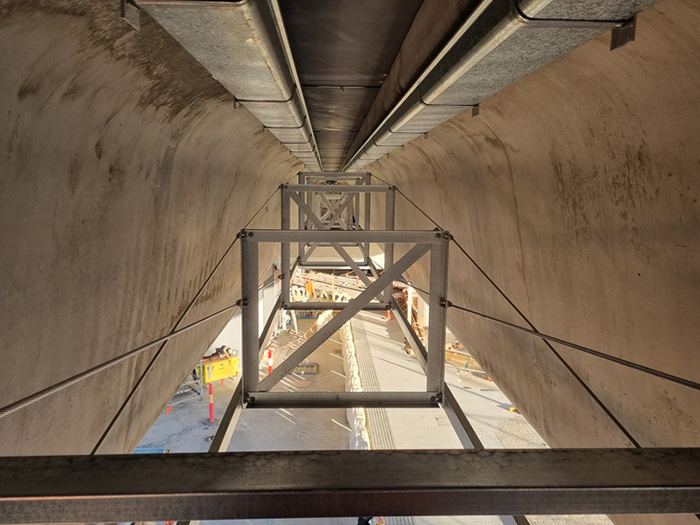A new era in sustainable infrastructure
On March 28th, 2024, the newly reconstructed metro stop at Narre Warren station was officially opened to the public. A popular interchange on Melbourne’s Pakenham Line, Narre Warren Station now sits elevated above the streets in a sleek skyline crossing – a significant achievement in the state’s ambitious Level Crossing Removal initiative aimed at addressing critical safety and congestion issues throughout the city. The Pakenham line has long been one of the busiest lines in Melbourne’s rail system.
The original design included 30 tonnes of steel in the form of multiple 800mm deep beams, each spanning 25 metres. The beams were required to support the ceiling between the tracks above the concourse. The sheer weight of the structure presented many inherent challenges, including a complex installation plan that would need to coincide with the installation of the U-Troughs to avoid potential disruptions to rail services and additional cranage costs. In response to these challenges, Built Environs sought an innovative solution from Ronstan Tensile Architecture.

Collaborating closely with Tensys Engineers, Ronstan designed and developed a pioneering cable truss system that dramatically reduced the required structural steel. This new design, utilising just three tonnes of tensioned ACS2 cables and bespoke galvanised steel elements, effectively replaced the cumbersome 30 tonnes of conventional structural steel. The lightweight, modular design was installed using only small cranes from the concourse below, with no impact to the above track operations.
Comprised of two pairs of precision-engineered stainless steel cables arranged in a bow truss configuration, the benefits of this cable truss solution extend far beyond its immediate structural advantages. The reduced weight of materials translates directly into energy savings during both the manufacturing and transportation phases, significantly lowering the project’s carbon footprint. Additionally, the modular nature of the cable system allows for incremental installation without disrupting rail operations, a critical consideration for a busy metro line. The ease with which this system can be dismantled also offers future flexibility, allowing for straightforward modifications or deconstruction as urban needs evolve.

Moreover, the environmental impact of the project is considerably mitigated. By reducing the need for 27 tonnes of steel, the resource dependency is dramatically lowered, conserving natural resources and reducing greenhouse gas emissions associated with steel production. This sustainable approach enhances the environmental credentials of the Narre Warren station and sets a precedent for future infrastructure projects within Melbourne and beyond.
As the first implementation of its kind, the structural cable system at Narre Warren station is a trailblazer, showcasing the potential for similar applications in upcoming projects. With several more stations associated with level crossing removals in Melbourne’s metropolitan rail system yet to be elevated, this project underscores a critical shift towards more sustainable, resource-efficient, and environment-friendly construction practices in urban infrastructure development.
The success at Narre Warren is a promising indicator of the broader adoption of such innovative solutions, paving the way for a more sustainable future in metropolitan transit systems.
Project details
Project: Narre Warren Station
Client: Built Environs for Western Program Alliance and MTM
Location: Melbourne, Australia
Product: Ronstan ACS2 Structural Cables, Custom Fabricated Galvanised Steel Elements
Application: Suspension and Structural Bracing
Completion: 2024

